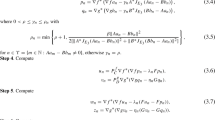Abstract
In this paper, we propose a Newton-type method for solving a semismooth reformulation of monotone complementarity problems. In this method, a direction-finding subproblem, which is a system of linear equations, is uniquely solvable at each iteration. Moreover, the obtained search direction always affords a direction of sufficient decrease for the merit function defined as the squared residual for the semismooth equation equivalent to the complementarity problem. We show that the algorithm is globally convergent under some mild assumptions. Next, by slightly modifying the direction-finding problem, we propose another Newton-type method, which may be considered a restricted version of the first algorithm. We show that this algorithm has a superlinear, or possibly quadratic, rate of convergence under suitable assumptions. Finally, some numerical results are presented.
Similar content being viewed by others
References
F.H. Clarke,Optimization and Nonsmooth Analysis (Wiley, New York, 1983).
R.W. Cottle, J.-S. Pang and R.E. Stone,The Linear Complementarity Problem (Academic, Boston, MA, 1992).
T. De Luca, F. Facchinei and C. Kanzow, A semismooth equation approach to the solution of nonlinear complementarity problems,Mathematical Programming 75 (1996) 407–439.
F. Facchinei and C. Kanzow, A nonsmooth inexact Newton method for the solution of large-scale nonlinear complementarity problems,Mathematical Programming 76 (1997) 493–512 (this issue).
F. Facchinei and J. Soares, A new merit function for nonlinear complementarity problems and a related algorithm,SIAM Journal on Optimization 7 (1997) 225–247.
A. Fischer, A special Newton-type optimization method,Optimization 24 (1992) 269–284.
A. Fischer, On the local superlinear convergence of a Newton-type method for LCP under weak conditions.Optimization Methods and Software 6 (1995) 83–107.
A. Fischer, An NCP-function and its use for the solution of complementarity problems, in: D.-Z. Du, L. Qi and R.S. Wormersley, eds.,Recent Advances in Nonsmooth Optimization (World Scientific, Singapore, 1995) 88–105.
C. Geiger and C. Kanzow, On the resolution of monotone complementarity problems,Computational Optimization and Application 5 (1996) 155–173.
P.T. Harker and J.-S. Pang, Finite-dimensional variational inequality and nonlinear complementarity problems: A survey of theory, algorithms and applications,Mathematical Programming 48 (1990) 161–220.
W. Hock and K. Schittkowski,Test Examples for Nonlinear Programming Codes (Springer, Berlin, 1981).
W.W. Hogan, Point-to-set maps in mathematical programming.SIAM Review 15 (1973) 591–603.
G. Isac,Complementarity Problems (Springer, Berlin. 1992).
H. Jiang and L. Qi, A new nonsmooth equations approach to nonlinear complementarity problems.SIAM Journal on Control and Optimization 35 (1997) 178–193.
C. Kanzow, Nonlinear complementarity as unconstrained optimization,Journal of Optimization Theory and Applications 88 (1996) 139–155.
C. Kanzow and H. Kleinmichel, A class of Newton type methods for equality and inequality constrained optimization,Optimization Methods and Software 5 (1995) 173–198.
O.L. Mangasarian, Equivalence of the complementarity problem to a system of nonlinear equations,SIAM Journal on Applied Mathematics 31 (1976) 89–92.
J.J. Moré and W.C. Rheinboldt, OnP- andS-functions and related classes ofn-dimensional nonlinear mappings,Linear Algebra and its Applications 6 (1973) 45–68.
J.M. Ortega and W.C. Rheinboldt,Iterative Solution of Nonlinear Equations in Several Variables (Academic, New York, 1970).
J.-S. Pang, Complementarity problems, in: R. Horst and P. Pardalos. eds.,Handbook of Global Optimization (Kluwer Academic, Bloston, MA, 1994) 271–338.
J.-S. Pang and S.A. Gabriel, NE/SQP: A robust algorithm for the nonlinear complementarity problem,Mathematical Programming 60 (1993) 295–337.
J.-S. Pang and L. Qi, Nonsmooth equations: motivation and algorithms,SIAM Journal on Optimization 3 (1993) 443–465.
L. Qi, Convergence analysis of some algorithms for solving nonsmooth equations,Mathematics of Operations Research 18 (1993) 227–244.
L. Qi and H. Jiang, Semismooth Karush-Kuhn-Tucker equations and convergence analysis of Newton and quasi-Newton methods for solving these equations,Mathematics of Operations Research, to appear.
L. Qi and J. Sun, A nonsmooth version of Newton’s method.Mathematical Programming 58 (1993) 353–367.
S.M. Robinson, Strongly regular generalized equations.Mathematics of Operations Research 5 (1980) 43–62.
P.K. Subramanian, Gauss-Newton methods for the complementarity problem,Journal of Optimization Theory and Applications 77 (1993) 467–482.
Author information
Authors and Affiliations
Additional information
Supported by Research Fellowships of the Japan Society for the Promotion of Science for Young Scientists.
Supported in part by the Scientific Research Grant-in-Aid from the Ministry of Education, Science and Culture, Japan.
Rights and permissions
About this article
Cite this article
Yamashita, N., Fukushima, M. Modified Newton methods for solving a semismooth reformulation of monotone complementarity problems. Mathematical Programming 76, 469–491 (1997). https://doi.org/10.1007/BF02614394
Received:
Revised:
Issue Date:
DOI: https://doi.org/10.1007/BF02614394




